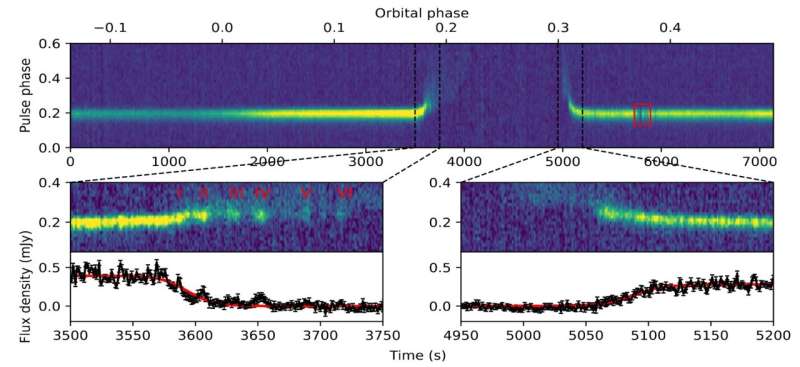Plasma lensing discovered in black widow pulsar

Using the Five-hundred-meter Aperture Spherical radio Telescope (FAST), a research team led by Dr. Wang Shuangqiang from the Xinjiang Astronomical Observatory (XAO) of the Chinese Academy of Sciences discovered plasma lensing phenomenon in a black widow pulsar PSR J1720-0533.
Black widow pulsar systems have a low-mass companion star in a compact orbit with a millisecond pulsar. They are characterized by ablating the companion by emission from pulsar. Black widow pulsars get their name from the “black widow” spiders, the females of which eat the males after mating. Black widow pulsars offer valuable opportunities to investigate the characteristics of the companion stars under intense irradiation.
In this study, the researchers found that the emission of PSR J1720-0533 during the ingress of the eclipse shows quasi-periodic modulations, which may be caused by plasma lensing.
By analyzing the lensing phenomenon, the researchers concluded that the maximum magnification for the lens is 1.6, corresponding to a lens size of tens of kilometers. The discovery of the plasma lensing phenomenon in PSR J1720-0533 demonstrates a link between the dispersion measurement and lensing.
Moreover, the researchers examined the polarization profiles near the eclipse of PSR J1720-0533 and found that the linear polarization of the emission disappeared before the dispersion measurement showed significant changes. This phenomenon provides strong evidence that there is a significant magnetic field in the companion.
These results suggest that magnetic fields play an important role in the eclipsing mechanism of black widow pulsars.
In addition, the researchers estimated the mass-loss rate of the companion to be 10-12 M⊙/yr and speculated that the companion will be destroyed completely in 1010 yr.
‘Black widow’ pulsar detected in globular cluster NGC 6712
S. Q. Wang et al, Unusual Emission Variations Near the Eclipse of Black Widow Pulsar PSR J1720−0533, The Astrophysical Journal Letters (2021). DOI: 10.3847/2041-8213/ac365c
Citation:
Plasma lensing discovered in black widow pulsar (2021, December 30)
retrieved 30 December 2021
from https://phys.org/news/2021-12-plasma-lensing-black-widow-pulsar.html
This document is subject to copyright. Apart from any fair dealing for the purpose of private study or research, no
part may be reproduced without the written permission. The content is provided for information purposes only.
For all the latest Science News Click Here
For the latest news and updates, follow us on Google News.

